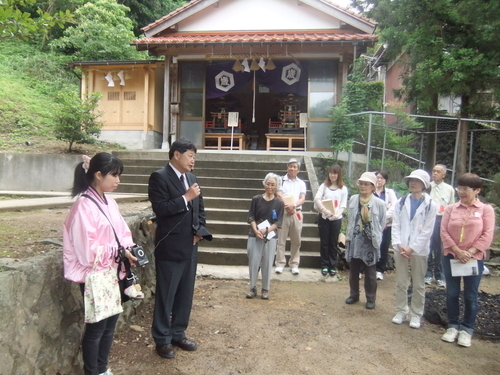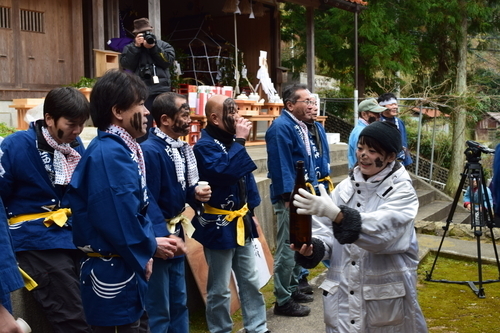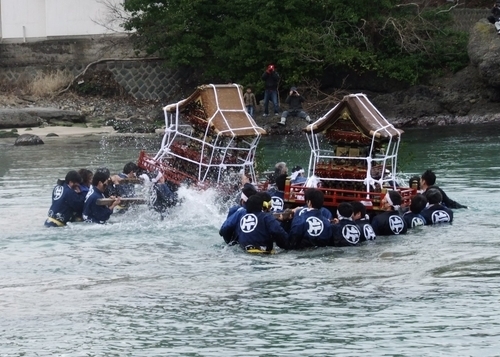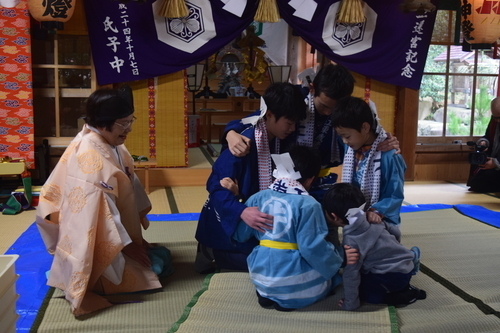katae-ura
| Bay Name | Katae-ura |
|---|---|
| Shrine Name | Zōōgongen(Former) Katae jinja(Current) |
| Deity |
Emperor Ankan Ukenorikami no mikoto |
| Location |
Matsue-shi Mihonoseki cho Katae 721 (Aza Kamidan) |
Katae ura Zōō gongen
Makoto arukatae to inoru kokoro ni wa
Ukiyo no chiri mo araji to omou

Regarding Katae ura; the Izumo Fudoki contains a Katae township, Katae beach and Katae yashiro (shrine), albeit written with different characters. The Fudoki listing for the Shimane district states, “The township of Katae is located 6.7 miles east of the district office. Kunioshiwake, a son of Susano-o, said, ‘The land I govern is in a good geographical condition.’ and as a result, it was named Kataye, well shaped land”, and also the entry, “Kataye Beach, 2090 feet wide, dwellings in the east and west.” In ancient times, the god worshipped in the Katae area was Kunioshiwake.
The ‘Unyoshi’ records on this location say, “Enshrined here are Zaōgongen and Kasute myoujin in an ‘aidono’ formation. (Enshrinement of two or more deities in one shrine building). Zaōgongen is Emperor Ankan, Katsute myoujin is Ukenori kami no mikoto. Also of note is the mention of the shrine “Uzukamyoujin”, with the deity Kunioshiwake, this looks likely to be the same Katae-yashiro as listed in the Fudoki.
In his report of 1863, Kanezaki Zanpei gives a brief mention of a shrine visit to this area with a reference to Katsute Myoujin, but since this is enshrined along with Zaogongen, it is thought to be in reference to this same shrine.
At present, in the Katae area there are two shrines, Katae-jinja in Katae town (Aza Kamidan) and Uzuka-jinja along the coastline. The question is, which of these shrines is connected to Zaogongen?
In the Meiji 8 (1875) ‘Imperial Topography’ survey, along with Katae-jinja, there are also details on a ‘Kamito’ shrine. This shrine is recorded as having the deities Emperor Ankan and Ukenori kami no mikoto. The shrine on the 42 bay pilgrimage, Zaogongen, was actually Kamito-jinja. This further raises more queries about locations. Katae-jinja is enshrined in the area known as Aza Kamidan where Kamito was formerly enshrined. The Katae-jinja of ancient times is thought to be along the coast, in the location of Uzuka-jinja.
In 1911, Kamito shrine was enshrined together with Katae-jinja hence the current status of Katae-jinja.
The Katae-yashiro of the Fudoki is actually Uzuka-jinja along the coast. There is an inscription on a memorial stone describing the location as ‘the remains of Katae-jinja’.It’s thought that the Katae-jinja worshiped at during the modern-day 42 bay pilgrimage was in face the Zaogongen of the Edo period. Worshipping at both shrines will connect you to 1300 years of history.

Matsue city’s New Year event, the ‘Sumitsuke’, has been featured on TV and other forms of media and is a well known reminder of the end of year season. While the parading of the o-mikoshi (portable shrine) through the town to bring health and household security for the coming year is a standard part of the Shimane Tondo new year tradition, the Sumitsuke involves the local women daubing black paint on their and the faces of all the participants and those viewing the proceedings. Traditionally, the paint was applied using Japanese radish as a ‘brush’.
This Tondo held on January 7th ends with two of the Toshitoku sama o-mikoshi being taken into the area of sea close to where the original Katae-jinja was enshrined. Sea water is splashed all over the shrine bearers providing watchers with quite a heroic spectacle which helps one forget the winter chill.
The o-mikoshi were built at the end of the Edo period and up to the end of the Pacific war, the event also included an additional ‘danjiri’ (floating shrine). On the forth Sunday every July an official ‘airing out’ Shinto ritual takes place to keep the shrines maintained.
The annual Katae-jinja festival held on October 14th traditionally involves elementary and junior high school girls performing the famous maiko dance and song performance ‘Urayasu no mai’. Local elementary students also get together and perform an offertory Sumo bout in the shrine’s Sumo ring.
While most adults are occupied preparing for the end of year festivities, on December 26th, children up to the age of ten perform the ‘Hizamochi shinji’, a Shinto rite involving the pounding of rice cakes using the knees as an offering to the shrine deity.
The former location of Katae jinja is located in Oyama near the harbor and commemorated with a stone bearing the information ‘Remains of Katae-jinja’ Before the road that runs along the area was constructed, it’s said that is was in the form of a small island out in the water.


| Bay Name | Katae-ura |
|---|---|
| Shrine Name | Zōōgongen(Former) Katae jinja(Current) |
| Deity |
Emperor Ankan Ukenorikami no mikoto |
| Location |
Matsue-shi Mihonoseki cho Katae 721 (Aza Kamidan) |
Katae ura Zōō gongen
Makoto arukatae to inoru kokoro ni wa
Ukiyo no chiri mo araji to omou
Regarding Katae ura; the Izumo Fudoki contains a Katae township, Katae beach and Katae yashiro (shrine), albeit written with different characters. The Fudoki listing for the Shimane district states, “The township of Katae is located 6.7 miles east of the district office. Kunioshiwake, a son of Susano-o, said, ‘The land I govern is in a good geographical condition.’ and as a result, it was named Kataye, well shaped land”, and also the entry, “Kataye Beach, 2090 feet wide, dwellings in the east and west.” In ancient times, the god worshipped in the Katae area was Kunioshiwake.
The ‘Unyoshi’ records on this location say, “Enshrined here are Zaōgongen and Kasute myoujin in an ‘aidono’ formation. (Enshrinement of two or more deities in one shrine building). Zaōgongen is Emperor Ankan, Katsute myoujin is Ukenori kami no mikoto. Also of note is the mention of the shrine “Uzukamyoujin”, with the deity Kunioshiwake, this looks likely to be the same Katae-yashiro as listed in the Fudoki.
In his report of 1863, Kanezaki Zanpei gives a brief mention of a shrine visit to this area with a reference to Katsute Myoujin, but since this is enshrined along with Zaogongen, it is thought to be in reference to this same shrine.
At present, in the Katae area there are two shrines, Katae-jinja in Katae town (Aza Kamidan) and Uzuka-jinja along the coastline. The question is, which of these shrines is connected to Zaogongen?
In the Meiji 8 (1875) ‘Imperial Topography’ survey, along with Katae-jinja, there are also details on a ‘Kamito’ shrine. This shrine is recorded as having the deities Emperor Ankan and Ukenori kami no mikoto. The shrine on the 42 bay pilgrimage, Zaogongen, was actually Kamito-jinja. This further raises more queries about locations. Katae-jinja is enshrined in the area known as Aza Kamidan where Kamito was formerly enshrined. The Katae-jinja of ancient times is thought to be along the coast, in the location of Uzuka-jinja.
In 1911, Kamito shrine was enshrined together with Katae-jinja hence the current status of Katae-jinja.
The Katae-yashiro of the Fudoki is actually Uzuka-jinja along the coast. There is an inscription on a memorial stone describing the location as ‘the remains of Katae-jinja’.It’s thought that the Katae-jinja worshiped at during the modern-day 42 bay pilgrimage was in face the Zaogongen of the Edo period. Worshipping at both shrines will connect you to 1300 years of history.
Matsue city’s New Year event, the ‘Sumitsuke’, has been featured on TV and other forms of media and is a well known reminder of the end of year season. While the parading of the o-mikoshi (portable shrine) through the town to bring health and household security for the coming year is a standard part of the Shimane Tondo new year tradition, the Sumitsuke involves the local women daubing black paint on their and the faces of all the participants and those viewing the proceedings. Traditionally, the paint was applied using Japanese radish as a ‘brush’.
This Tondo held on January 7th ends with two of the Toshitoku sama o-mikoshi being taken into the area of sea close to where the original Katae-jinja was enshrined. Sea water is splashed all over the shrine bearers providing watchers with quite a heroic spectacle which helps one forget the winter chill.
The o-mikoshi were built at the end of the Edo period and up to the end of the Pacific war, the event also included an additional ‘danjiri’ (floating shrine). On the forth Sunday every July an official ‘airing out’ Shinto ritual takes place to keep the shrines maintained.
The annual Katae-jinja festival held on October 14th traditionally involves elementary and junior high school girls performing the famous maiko dance and song performance ‘Urayasu no mai’. Local elementary students also get together and perform an offertory Sumo bout in the shrine’s Sumo ring.
While most adults are occupied preparing for the end of year festivities, on December 26th, children up to the age of ten perform the ‘Hizamochi shinji’, a Shinto rite involving the pounding of rice cakes using the knees as an offering to the shrine deity.
The former location of Katae jinja is located in Oyama near the harbor and commemorated with a stone bearing the information ‘Remains of Katae-jinja’ Before the road that runs along the area was constructed, it’s said that is was in the form of a small island out in the water.






